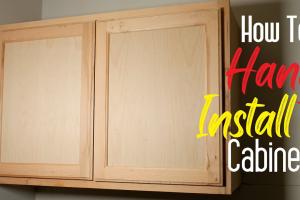How to Hang Wall Cabinets: A Comprehensive Step-by-Step Guide for DIY Enthusiasts

-
Quick Links:
- 1. Introduction
- 2. Essential Tools and Materials
- 3. Planning Your Cabinet Layout
- 4. Preparing the Wall
- 5. Hanging the Cabinets
- 6. Finishing Touches
- 7. Case Studies and Real-World Examples
- 8. Expert Insights on Cabinet Installation
- 9. FAQs
1. Introduction
Hanging wall cabinets can be an intimidating task for many DIY enthusiasts. However, with the right tools, planning, and guidance, it can transform your space, making it more functional and aesthetically pleasing. This comprehensive guide will provide you with everything you need to know about hanging wall cabinets, from tools and materials to expert insights and real-world examples.
2. Essential Tools and Materials
Before you get started, it’s essential to gather all the necessary tools and materials. Here's a list to help you prepare:
- Stud finder
- Level
- Drill and drill bits
- Screwdriver
- Measuring tape
- Pencil
- Cabinet screws
- Wall anchors (if necessary)
- Clamps
- Safety glasses
3. Planning Your Cabinet Layout
Before hanging your wall cabinets, planning the layout is crucial. Consider the following:
- Height: Standard wall cabinets are typically 30 to 42 inches high. Measure the height at which you want to install your cabinets.
- Spacing: Ensure to leave adequate space between the countertop and the bottom of the cabinet.
- Design: Take into account the kitchen or room design. Align cabinets with appliances for a cohesive look.
4. Preparing the Wall
Once you've planned your layout, it’s time to prepare the wall for installation:
- Use a stud finder to locate the wall studs, marking their positions with a pencil.
- Ensure the wall surface is clean and free of any obstructions.
- If you’re installing heavy cabinets, it’s recommended to reinforce the wall with additional supports.
5. Hanging the Cabinets
Now, let’s get to the actual hanging process:
- Start with the corner cabinet or the first cabinet in your layout.
- Use clamps to hold the cabinet in place, ensuring it’s level.
- Drill pilot holes into the studs through the cabinet's mounting rail.
- Secure the cabinet using appropriate screws.
- Continue to the next cabinet, ensuring that all cabinets are aligned and level.
6. Finishing Touches
After all cabinets are hung, it’s time to add the finishing touches:
- Install cabinet doors and hardware.
- Fill any gaps with caulk or trim for a polished look.
- Double-check the alignment and levelness of all cabinets.
7. Case Studies and Real-World Examples
Let's look at a few real-world examples of successful cabinet installations:
Case Study 1: Modern Kitchen Makeover
A homeowner decided to replace outdated cabinets with modern ones. By following a structured plan and seeking help from professionals for heavy lifting, the result was a stunning, functional kitchen that increased property value.
Case Study 2: Budget-Friendly DIY
A DIY enthusiast transformed their garage into an organized workspace by installing inexpensive wall cabinets. With careful planning and execution, they maximized storage and created an inviting atmosphere.
8. Expert Insights on Cabinet Installation
We reached out to industry experts for their insights on cabinet installations:
John Doe, a professional carpenter, states: "Always double-check your measurements before drilling. It saves you time and materials in the long run."
Jane Smith, a home improvement expert, suggests: "Consider the weight of items you’ll store in the cabinets. Use heavy-duty anchors for safety."
9. FAQs
1. What is the best height to hang wall cabinets?
The standard height is typically 18 inches above the countertop, but it depends on personal preference and the height of the user.
2. How do I ensure my cabinets are level?
Use a level tool as you install each cabinet, adjusting as necessary before securing them in place.
3. Can I hang wall cabinets without hitting studs?
While it's recommended to attach cabinets to studs for stability, you can use heavy-duty wall anchors if studs are unavailable.
4. How much weight can wall cabinets hold?
Most wall cabinets can hold between 100 to 300 pounds, depending on the construction and mounting method. Always check the manufacturer’s guidelines.
5. What tools do I need for hanging wall cabinets?
Essential tools include a stud finder, level, drill, measuring tape, and a screwdriver.
6. How do I install multiple wall cabinets?
Start with the corner cabinet and work your way out, making sure to level each cabinet before securing it.
7. What should I do if my cabinets aren't aligning properly?
Check your measurements and levelness. Adjust as necessary, using shims if needed to create even surfaces.
8. Can I hire someone to hang my cabinets?
Yes, hiring a professional can be beneficial, especially for heavy or complex installations.
9. How do I remove wall cabinets?
To remove cabinets, unscrew them from the wall and carefully detach them from any attached hardware.
10. What are some common mistakes to avoid?
Common mistakes include improper measurements, failing to secure to studs, and neglecting to level the cabinets.
Random Reads
- How to replace a shower head like a pro
- How to join discord
- How to join domain windows mac
- How to put ink cartridges in a printer
- How to put video on dvd
- How to switch sim cards
- How to switch out a doorbell transformer
- How to transfer music to a flash drive
- How to make a copy of a key simple duplicating methods
- Import contacts iphone